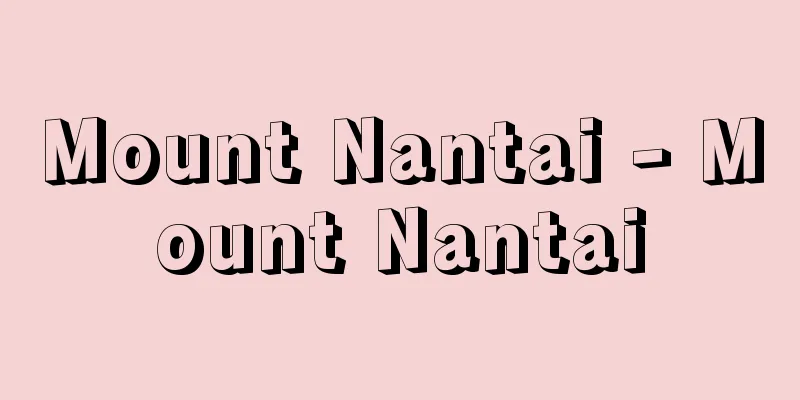Song

|
A form of artistic expression through sound. It is written with various Chinese characters such as uta, ko, ko, uta ... The word "kayo" used in China came to be used by Japanese literature scholars in place of "ouka" after the Meiji period. "Uta" is sometimes used to refer to vocal expressions with strong musicality, as opposed to "kotoba" (words) with weak musicality, but "uta" is sometimes used to refer to artistic vocal expressions that often involve prolonged syllables and are melodic, as opposed to "narrative" which does not involve much prolongation of syllables and tries to make the rhythm of the language correspond to the beat, regardless of the issue of current value, as opposed to "narrative" which is more recitation-like. In medieval Sarugaku Noh, the characters "uta" and "fu" were used to refer to vocal music, which is a special usage, but in musical terms, vocal music in contrast to instrumental music is sometimes referred to as "utamono" or "utaimono", and is sometimes used as "utamono" or "utaimono". In the early modern Edo period, there was a tendency to use the character "uta" to emphasize the song-like nature of the song, in contrast to literary "uta" and vocal music such as narrative joruri, but in the Kansai region, the character "uta" was retained and such characteristics were emphasized. Source: Encyclopaedia Britannica Concise Encyclopedia About Encyclopaedia Britannica Concise Encyclopedia Information |
|
音声による芸術的表現の一つ。歌,哥,謌,謳,謡,諷,唱,詠,唄などさまざまな漢字をあてる。その語源にも諸説あり,手拍子を「打つ」ことに由来するとする説や,情感を「うったふ」または「うれたふ」から出たとする説などがあり,その動詞形の「うたふ」との先後関係も明らかではない。古代においては,実際に声を出して歌われるものに「歌」もしくはその異体字をあてたが,中国の詩賦をまねて文芸本位の読む「和歌」が成立して,その区別に混乱が生じた。中国では,楽器に合せるものを「歌」,無伴奏のものを「謡」または「謳」とし,また,斉唱の歌を「謳」などと区別したこともあったが,日本ではすべて同義として「うた」の語にあてた。中世には,実際に歌われるものは,特に「謳歌」と字を重ねて区別したこともある。中国で用いられていた「歌謡」の語は,明治以降に国文学者などによって「謳歌」に代えて使われるようになった。音声表現のうちで音楽性の強いものを「うた」として,音楽性の弱い「コトバ」との対概念として用いることもあるが,芸術的な音声表現のうちで特に音節の引延ばしが多く,そこに旋律性が加えられたものを「うた」とし,あまり音節は引き延ばさず,時価の問題は別として,言語の韻律を拍に対応させようとする朗誦性の強い「語り」に対する概念として用いることもある。中世の猿楽能において,その声楽に「謡」「諷」などの字をあてて「うたひ」と称したのは特殊な用法であるが,音楽用語としては,器楽に対する声楽を特に「うたもの」または「うたいもの」と称して,「歌物」「謡物」などとあてることもある。近世の江戸においては,「唄」の字をあてて,文芸上の「歌」や語り物の浄瑠璃などの声曲に対して,歌曲性を強調する場合に用いる傾向も生じたが,関西においては「歌」の字をあてたままでそうした性格を強調した。
出典 ブリタニカ国際大百科事典 小項目事典ブリタニカ国際大百科事典 小項目事典について 情報 |
Recommend
type II conditioning
...Therefore, conditioning can occur even if the ...
High sumo wrestler - Kourikishi
A eunuch from the prosperous Tang Dynasty in Chin...
Lying Dragon Bamboo
...Water tricks have been used since the Kanbun p...
Arakutokenaganomi - Arakutokenaganomi
...The Chinese sand flea, Tunga caecigena , takes...
Algonquin peoples
…Such valuable shell money is nothing more than a...
Surabaya - Surabaya (English spelling)
A port city on the northeast coast of Java Island...
Ahmad Shah Durrani
1722‐72 Founder of the Durrani dynasty (1747-1842)...
Sunan al-Tirmidhi (English spelling)
…Although he was blind, he traveled to Khorasan, ...
Nineteen
⇒ Jippensha Ikku Source: Kodansha Digital Japanese...
IJssel
…The topography that forms the backbone of the co...
Benivieni, A.
...Pathology as an academic discipline is divided...
Ultrasound cardiography
…Ultrasound is a method of recording the movement...
Yoshiyuki Shiba
Year of death: May 7, 17th year of the Oei period ...
Kawaguchi Jinzaburou
...Japanese stringed instrument (illustration). A...
Borgia, R. (English spelling) BorgiaR
…Reigned 1492-1503. His real name was Rodrigo Bor...









